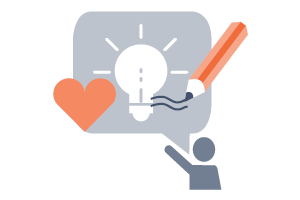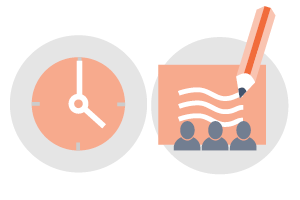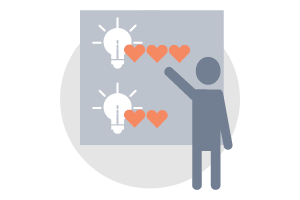The objective of brainstorming is for a group to share and consider various possible solutions to a well-defined problem, or to express diverse perspectives about a clear and shared goal. A brainstorming exercise further allows all participants to freely share their views, without the risk of their ideas being criticised.
OVERVIEW
Participants freely share their ideas about a specific goal or problem. All ideas submitted are captured by the facilitator, and grouped around core themes that emerge from the exercise.
WORKSHOP PHASE
NUMBER OF PARTICIPANTS
Any number of participants
For larger groups, the participants can be allocated to smaller break-out rooms/groups, e.g. five to ten participants per group. Each break-out room will follow the same implementation steps, below, and report back to the larger group.
TIME |
MODE OF DELIVERY
Minimum 30 minutes | F2F & Online
TOOLS/MATERIALS
- A whiteboard and whiteboard markers, OR a vacant wall space, post-its/sticky notes and pens. Online version: An online collaboration tool, with a whiteboard function that can be edited and screen-shared.
PREPARATION
- The facilitator should decide on the goal/problem that will be brainstormed, and clearly define it.
- The facilitator should familiarise themselves with the principles of effective brainstorming. (See: Step 2, below).

Step 1
The facilitator should start by explaining the objective of the exercise, namely for the group to think creatively about the problem/goal, so that they can eventually identify improved ideas and suggestions.

Step 2
The facilitator explains the principles of effective brainstorming, namely:
- All ideas are welcome, no matter how ambitious or unconventional, and will not be criticised.
- All ideas will be recorded by the facilitator. If the facilitator’s note of a particular idea does not effectively express what the participant meant, the participant should clarify their contribution.
- Ideas should be shared briefly, and not be elaborated on in too much detail, given the time limit and the aim of everyone having a turn to contribute.
- Participants should try to build on one another’s ideas, and not repeat what has already been shared.
Herewith more brainstorming principles and ground rules.

Step 3
The facilitator starts the brainstorming session by sharing their definition or description of the shared goal/problem. The participants should confirm their understanding of the topic, and can volunteer alternative ways of phrasing the goal/problem.

Step 4
The session starts, and the facilitator (or time-keeper) also starts a timer. Each idea, volunteered by a participant, is recorded on the (online/in-person) whiteboard. The facilitator tries to visually cluster the ideas around core themes that will emerge.

Step 5
Once the time has run out, the facilitator concludes the session. (They can first alert the participants when only 2-3 minutes are left, and ask them to share any urgent ideas that they feel have not been heard during these final minutes).
The session is concluded by discussing the core themes that arose, and the general types of ideas that were shared around each theme. Alternatively, participants can put a checkmark/sticker by their favourite 3-4 ideas. Online version: Online whiteboards should allow participants to collaborate on the platform, and add icons or notes next to ideas. Alternatively, they can indicate their favourite ideas, per theme, in the online chat function.

Step 6
As a session output, the facilitators can take a picture/screenshot of the whiteboard, and compile a list of the most favoured/innovative ideas and key themes that emerged. These outputs can be shared with the group after the workshop, so that it can be applied by participants or a dedicated task team during a post-workshop planning session.
- Brainstorming sessions should be subject to a time limit – with the active contribution phase (when ideas are shared) typically no longer than 20 minutes - as the exercise requires a lot of intense focus and active input from participants. The facilitator can also wrap up the exercise earlier, if they notice participant engagement is starting to decline.
- Brainstorming is most effective if focused on a goal/solution that the participants are all very familiar with, and that they have roughly the same level of relevant experience/knowledge to draw on. They should also have a shared understanding of key concepts, relevant to the topic, as misinterpretations about the ‘what’ and ‘why’ of the goal/solution can derail the session.
Brainstorming was first introduced in 1948 by advertising executive Alex F. Osborn in his book "Your Creative Power."
The participants can also write their ideas on post-it notes, rather than sharing them verbally. After approx. 10 minutes, they would then be asked to choose their favourite 2-4 ideas, and stick them on the whiteboard.
« Methods

